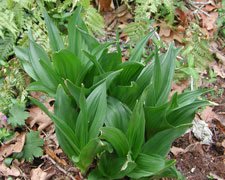Resource Library
Plant of the Week: Sacred Lily, Japanese
The University of Arkansas System Division of Agriculture does not promote, support or recommend plants featured in "Plant of the Week." Please consult your local Extension office for plants suitable for your region.
Plant of the Week
Japanese Sacred Lily
Latin: Rohdea japonica

Every civilization develops a tapestry of traditions, beliefs, superstitions and symbolism, making it unique and interesting. Symbolic traditions associated with plants - think Easter lily and poinsettia - aren’t unique to our culture.
The Japanese Sacred Lily (Rohdea japonica) is one of the most cherished plants in that nation but understanding its popularity when viewed from a Western perspective is challenging.
Rohdea is an evergreen herbaceous perennial native to both China and Japan where it occurs in moist woodlands and on grassy slopes. It’s now classified as a member lily-of-the-valley family which was recently split out of the overly large lily family. It grows from a slowly expanding underground crown and sends up thick, rich green 18-inch long leaves to 3 inches wide in the middle.
In spring, it sends up an odd greenish white bloom spike that never extends out of the canopy of leaves. If slugs are available, it will be pollinated and produce a cluster of Italian-arum-like bright red berries that persist through the fall and winter.
Rohdea has traditionally been considered monotypic with only this one species known, but in 2003 a Japanese botanist proposed merging three closely related genera into this species and increasing the species count to 10.
Rohdea has been cultivated in Japan for at least 500 years and perhaps as long in China. It’s a “good fortune” plant often given as a gift at housewarming parties, when a new business opens or as birthday present.
Its Chinese name translates as “10,000 years green,” and it’s believed to be an iconic rebus - something that multiplies the good luck of other items. A rebus - usually represented as a symbol or pictogram - transfers meaning as an enigmatic expression.
It’s Japan where the popularity of Rohdea, where it’s called omoto, has reached its zenith. There the plant is not grown in gardens but in pots as a kind of herbaceous bonsai. The Japanese Rohdea Society has registered over 600 named cultivars, some of which sell to collectors for thousands of dollars. Rohdea shows are held just as we hold orchid or daylily shows. They classify cultivars according to the length and thickness of the leaf, leaf shape and the presence and type of variegation. The pot they’re grown in - called a nishiki bachi - is an important part of the overall display.
The number of Rhodeas offered for sale in this country is limited to the faster growing kinds. One source lists 10 cultivars, including several variegated forms. Because they’re slow growing and must be propagated by division, the cultivars tend to be pricier than the green-leafed forms which can be raised from seed.
Rhodeas are great woodland plants where they can be used as a groundcover, to edge walkways or as specimen plants. They’re evergreen through zone 6 and will survive even further north, but the foliage will die back each winter. Give them the same kind of conditions as hostas; preferably a well drained, moist woodland soil. But they’re tough enough to grow in less than perfect conditions, including clayey soils. Clumps can be divided in early spring. They have no serious pests.
By: Gerald Klingaman, retired
Extension Horticulturist - Ornamentals
Extension News - June 8, 2007
The University of Arkansas System Division of Agriculture does not maintain lists of retail outlets where these plants can be purchased. Please check your local nursery or other retail outlets to ask about the availability of these plants for your growing area.